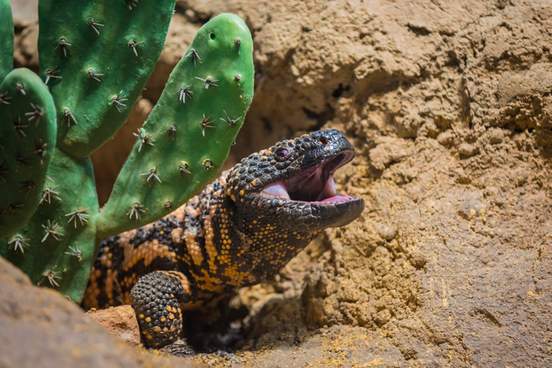
Gila Monster
Definition:
a large, stout, venomous lizard (Heloderma suspectum) that has rough, bumpy, black and orange, pinkish, or yellowish skin, a thick tail, and venom glands in the lower lip and that is found especially in arid regions of the southwestern U.S. and northwestern Mexico
Example:
Hidden in a narrow canyon in the eastern Mojave Desert, the caverns that opened to the public more than 80 years ago are a lure for geology fans and outdoor adventurers. Their glittering passages and chambers are the main attraction of the 5,900-acre Providence Mountains State Recreation Area, home to ringtail cats, desert bighorn sheep and one of the only known colonies of Gila monsters west of the Colorado River.
— Louis Sahagun, The Los Angeles Times, 29 Sep. 2017
Note:
Book lovers of a certain age may remember one of the first books ever featured on the long-running PBS series Reading Rainbow: Marjorie Weinman Sharmat’s Gila Monsters Meet You At the Airport, which introduced that beautiful creature to a generation. The Gila monster is a large venomous lizard with an unusual name. The Gila part (which rhymes with the name Shelia) comes from the name of the Gila river in Arizona and New Mexico, itself a Spanish transcription of a Native name for the river or region. And monster? You may judge for yourselves, but the venom of the Gila monster is roughly equivalent to that of a diamondback rattlesnake (though rarely fatal to humans).
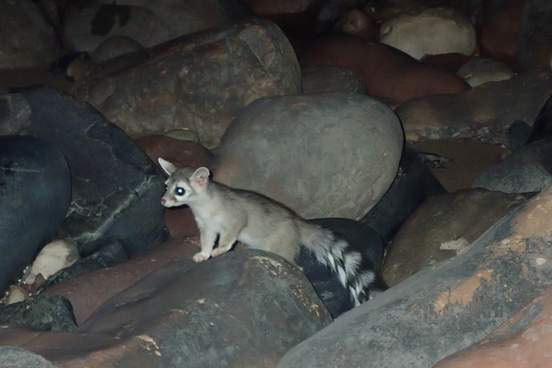
Ringtail
Definition:
a carnivore (Bassariscus astutus) of the western U.S. and Mexico that is related to and resembles the raccoon
Example:
Ringtails are about the size of a large squirrel, and they climb trees as well as squirrels, including descending head first. They can move very fast and jump from tree to tree like a squirrel. They are omnivores, eating just about any small animal, fruit, green leaves, crayfish and insects. Years ago, miners caught them and put them in mines to catch rats and mice, and they were called Miner's cats. They are strictly nocturnal and thus almost never seen in the daylight, so many folks never know they are there.
— Jim Stanley, The Blanco County (Texas) News, 20 July 2022
Note:
When is a raccoon not a raccoon? When it is related to a raccoon and kinda looks like a raccoon (and may, heaven forfend, be predated on by a raccoon) but is in fact a ringtail. While a ringtail’s tail has–surprise, surprise–rings that suggest those of its distant cousin, the ringtail itself is much smaller, smaller than the average house cat even. The range of ringtails in the United States is also limited to the west and southwest, while raccoons are common across most of North America. The ringtail is also occasionally referred to as a cacomistle, a word which comes (via Mexican Spanish) from the Nahuatl tlahcomiztli, a combining of tlahco (“half”) + miztli (“mountain lion”).
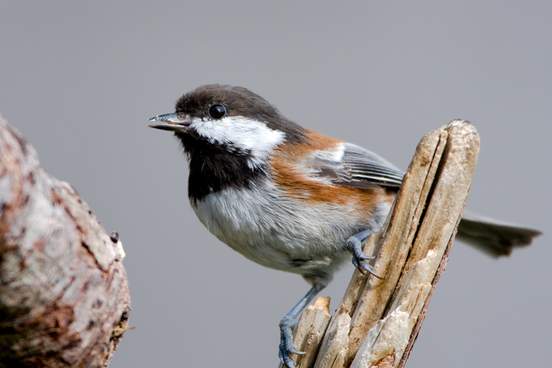
Chestnut-Backed Chickadee
Definition:
a brown-backed chickadee (Poecile rufescens) of the western U.S.
Example:
Did you know that more than 180 species of birds breed in Sonoma County? We are lucky to have many different environments that provide ideal nesting habitat for numerous species of birds. On my property, which is a mix of open grasslands, old apple orchards, deciduous forests and a riparian area with a creek, we have a wide range of nesting birds. … Right outside our bedroom window, an oak titmouse pair returns every year to nest in a small apple tree, while chestnut-backed chickadees raise their young in a nest box on the fence.
— Sarah Klobas Brooks, The Sonoma County (California) Gazette, April 2023
Note:
The word chickadee is imitative, meaning it comes from an approximation of a sound (in this case one of the sounds made by a number of related songbirds common throughout North America). The most widespread is the black-capped chickadee, year-round backyard favorite for most of the northern half of the lower-48 and the southern half of Canada and Alaska. But there are other chickadees with smaller ranges, including the Carolina chickadee (the Southeast), boreal chickadee (Alaska and Canada and a few select places along the U.S./Canada border including far northern New England), mountain chickadee (mountainous regions of the west from Canada to the Baja Peninsula), and the chestnut-backed chickadee, whose range mostly hugs the Pacific coastline from Alaska to California, with an inland pocket that includes parts of Idaho and Montana. This chickadee, true to its name, has chestnut-colored plumage on its back and also its sides.
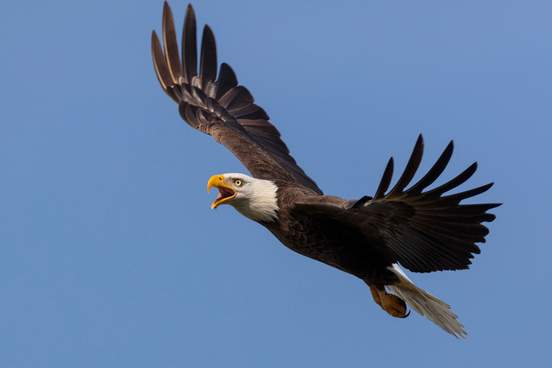
Bald Eagle
Definition:
an eagle (Haliaeetus leucocephalus) of North America that is brown when young with white only on the undersides of the wings but in full adult plumage has white head and neck feathers and a white tail
Example:
In addition to their patriotic symbolism, bald eagles have a number of traits that makes seeing one a memorable experience. However, among frequently cited impressive characteristics such as size, diving speed and vision; there are a few lesser-known bald eagle traits that seldom get mentioned. And this brings us back to the question–can a bald eagle swim? The answer is "yes." Though it's probably not their preferred means of travel and it's not a common sight, eagles can swim. In situations where a prey item was too large to lift from the water, eagles have been seen swimming their catch to shore where they could tend to it better.
– Francis Skalicky, The Bolivar (Missouri) Herald-Free Press, 20 Jan. 2023
Note:
While it may seem strange to include bald eagles on a list of region-specific animals, given that they are regular inhabitants of every state, excepting Hawaii, that fact wasn’t true even in the recent past. The only eagle uniquely native to North America, the bald eagle (so called due to the birds’ characteristic white-feathered heads) was endangered in the second half of the 20th century. Following loss of habitat and exposure to insecticides, the population declined until they could only be found in Alaska and Florida. Legislation was passed by Congress from the 1940s to the 1970s to save the bald eagle. Today the bald eagle is considered a success story of the Endangered Species Act with more than 70,000 breeding pairs found from Texas to Florida and north to New York, with a robust population in Alaska.
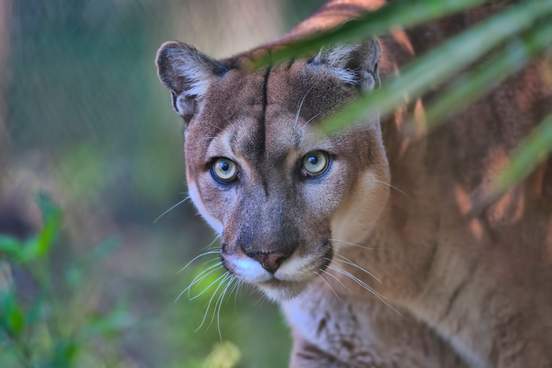
Florida Panther
Definition:
a highly endangered cougar (Felis concolor coryi) whose range is now limited to southern Florida
Example:
A federal agency charged with protecting endangered plants and animals is considering a wildlife corridor that would stretch from Naples to the Lakeland area. … The program would be a willing-seller situation, where large landowners could sell their land outright or get conservation easements in exchange for development credits. The land would not be turned into subdivisions or golf course communities, either way. The idea is to create more connectivity between areas like Everglades National Park and the Big Cypress National Preserve to areas north of Lake Okeechobee, so that animals like the Florida panther can increase their range.
— Jim Gillis, The Naples (Florida) Daily News, 11 Apr. 2023
Note:
Could the Florida panther (a subspecies of the cougar) one day be a bald-eagle level conservation success story? Though Florida panthers, despite their name, were once found as far north as Tennessee and as far west as Louisiana, their habitat was broken into isolated segments by highways and urban sprawl. Today there is an initiative to reconnect these habitats and expand the range and breeding population of the Florida panther. These conservation efforts were recently documented in an award-winning film. The cougar and its subspecies enjoy a number of different, often regional names, including painter (an alteration of panther), puma, catamount, and mountain lion.

Fisher
Definition:
a dark brown North American carnivorous mammal (Pekania pennanti synonym Martes pennanti) of the weasel family
Example:
Just a few miles from downtown Ithaca, eerie screams can be heard piercing the night. The alarming cries sound like a woman screaming, say some who have heard them. The sounds are enough to send shivers down the spines of even the most avowed rural residents. … Area wildlife experts attribute the nocturnal sounds to red foxes, despite some guesses that the screams are from fishers, a small, reclusive member of the weasel family that's a close relative to martens and wolverines. “While there is a common perception that fishers do make that sort of screaming noise, we actually don’t have any great documentation of those coming from a fisher that we could confirm,” said Sabrina Horrack, Collections Manager of SUNY-ESFRoosevelt Wild Life Collections.
— Kate Collins, The Ithaca (New York) Journal, 1 Sep. 2022
Notes:
The fisher (also known as the fisher cat, wejack, or pékan) is a member of the weasel family that is frequently confused with mink and the pine marten. While all three have been hunted for their pelts, the fisher is larger than either the marten or mink. Fishers live in dense woodland and their population was previously threatened not only by trapping but also by logging. More recently, however, they have been re-introduced into the northern boreal forests of North America, from Oregon and Washington, through the Great Lakes, and into New York, Pennsylvania, and New England. Contrary to what their name suggests, fishers do not catch or eat fish (at least live fish, anyway–they will eat dead fish if they find it). Some have theorized that European settlers gave the animal its most common name due to its similarity to the European polecat, which was also called a “fitchet,” “fitchew,” “fitchole,” or “ficher.”
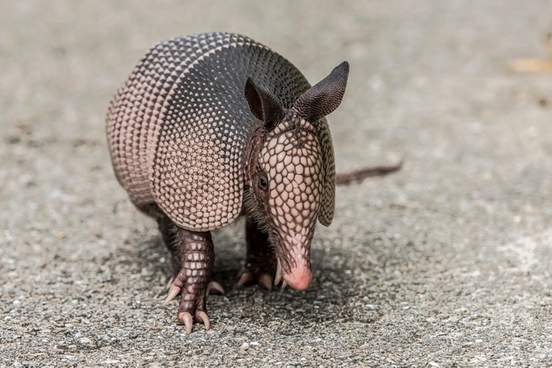
Armadillo
Definition:
any of a family (Dasypodidae) of burrowing edentate mammals found from the southern U.S. to Argentina and having the body and head encased in an armor of small bony plates
Example:
Historically, nine-banded armadillos have thrived in the Southwest, with Texas hosting the largest population in the country… But thousands of miles farther north, the armadillo is being spotted more frequently. Armadillos have been traveling up rivers and streams to the Midwest in recent years, and thousands of them are being spotted year-round as far north as Nebraska, Iowa and Illinois.
— John Murphy, Newsweek, 27 July 2022
Note:
Armadillos are members of a family (Dasypodidae) of burrowing mammals covered in multiple hard plates of scaled armor–armor and armadillo share the same Latin roots–with each segment slightly overlapping the next such that they can expand and contract like an accordion. The number of segments (called bands) identifies the type of armadillo. The three-banded armadillo is found in South America. The nine-banded armadillo (Dasypus novemcinctus) is the only species of armadillo in the United States. First observed and still most commonly found in Texas, the nine-banded armadillo is also unique among mammals, as its offspring are born in litters of four identical quadruplets developed from a single egg.
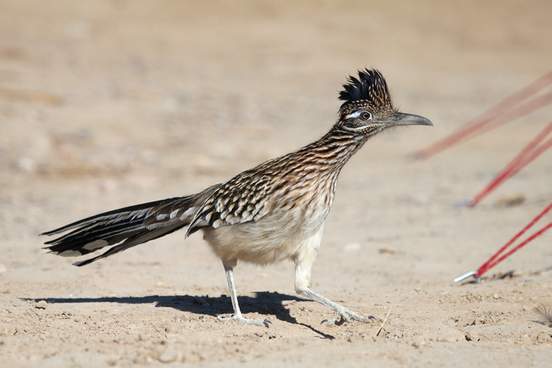
Roadrunner
Definition:
a largely terrestrial bird (Geococcyx californianus) of the cuckoo family that has a long tail and a crest, is a speedy runner, and inhabits arid regions from the southwestern U.S. to Mexico
Example:
Regular bathing is an important part of the self-maintenance routine of many birds. Bathing in water is the usual approach, but water isn’t always easy to find—especially in the desert habitat of the Greater Roadrunner. However, roadrunners make the most of what’s available. They take dust baths frequently, flopping down in loose, dry dirt, then moving their feet and fluttering their wings to spray fine dust up over their bodies. When they preen the dust out of their feathers, it helps to remove grease, flakes of dry skin, and perhaps a few lice or other external parasites.
— Kenn Kaufman, Audubon.org, 23 Feb. 2023
Note:
Roadrunners are found from southern California through Texas, and while they thrive in the Sonoran Desert, they’ve also been observed as far east as the swamps of Louisiana. Roadrunners can fly, but not for long periods or distances. They are, however (as their name suggests), excellent runners. These birds can clock 15 miles per hour on a straightaway and will run literal circles around their prey. They’ve been documented disorienting snakes and lizards with their dizzying circles and then attacking from behind with their sharp beaks–no dynamite or anvils needed. And contrary to the cartoons, a roadrunner is not by any stretch of the imagination a natural predator of coyotes.
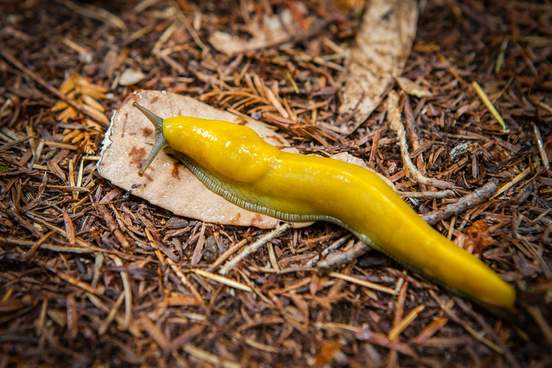
Banana Slug
Definition:
any of a genus (Ariolimax) of large slugs native to moist forests of western North America that have a long, fusiform body and are sometimes bright yellow in color with brown or black spots
Example:
During unhurried hikes, even the sea air tastes good. Poking along a Portland Island trail, flanked by the gnarled limbs of oaks and arbutus trees with sword ferns at your feet, naturalist Jordan Hawkswell's commentary slides nature beneath the microscope of your mind when you bend to inspect a slimy plump banana slug.
— Michele Jarvie, _The Calgary (Alberta) Herald, 10 Dec. 2022
Note:
And we are off to the races! Yes, banana slugs are among the slugs that handlers field in “slug races” in the Pacific Northwest and Alaska, where the first slug across the line (or outside of the circle) wins. Some superstitious tales even say you should kiss these yellow gastropods when you come across them, for good luck. We do not encourage such behavior. It won’t hurt you (apart from making your lips tingle due to chemicals in their secretions), but it might hurt the slug. A friendly nod is just as lucky should you encounter one of these fellas on a hike. Rather than refer to a single species, banana slug is used for a host of poky little critters, including the slender banana slug, Button’s banana slug, and Southern Pacific banana slug.
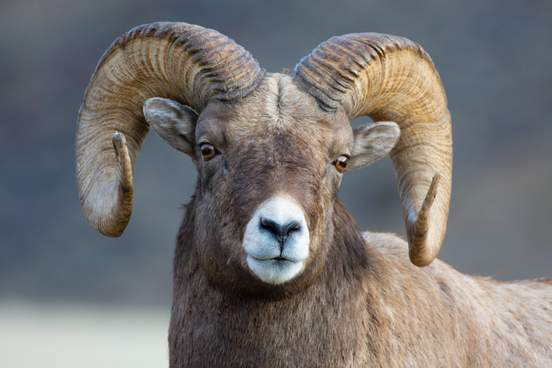
Bighorn Sheep
Definition:
a usually grayish-brown wild sheep (Ovis canadensis) of mountainous and desert regions of western North America
Example:
No matter how often they are seen, the Rocky Mountain bighorn sheep in the Clifton-Morenci area draw much attention and a sense of awe. That certainly includes motorists who stop and try to capture the sheep on their cell-phone cameras. That happened Monday, Feb. 20, near the Marathon (formerly Conoco) convenience store in Morenci. A herd was grazing along a road across from the store. They did so without a seeming care in the world, although traffic passed to and from or by the store and vehicles continuously drove in and out of the store's parking lot.
— Walt Mares, The Copper Era (Clifton, Arizona), 27 Feb. 2023
Note:
Bighorn sheep are wild sheep known for their (wait for it) very big horns. While both the male (rams) and female (ewes) have horns and a white patch on their rumps, the horns of the ram are massive, curving up and back over their ears and then up and forward toward their cheeks. They use these horns in head-to-head dominance battles with other males. In the 19th century bighorn sheep were hunted until the general population dwindled. Today they are more vulnerable to livestock diseases. While officially they remain threatened as a species, their current population is stable.





